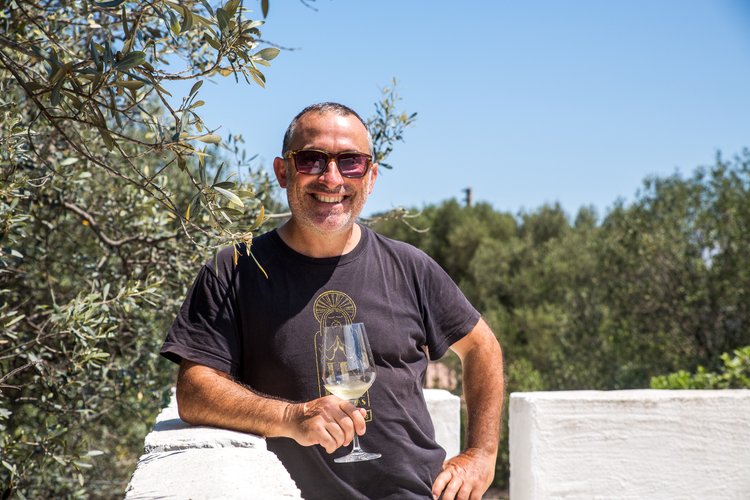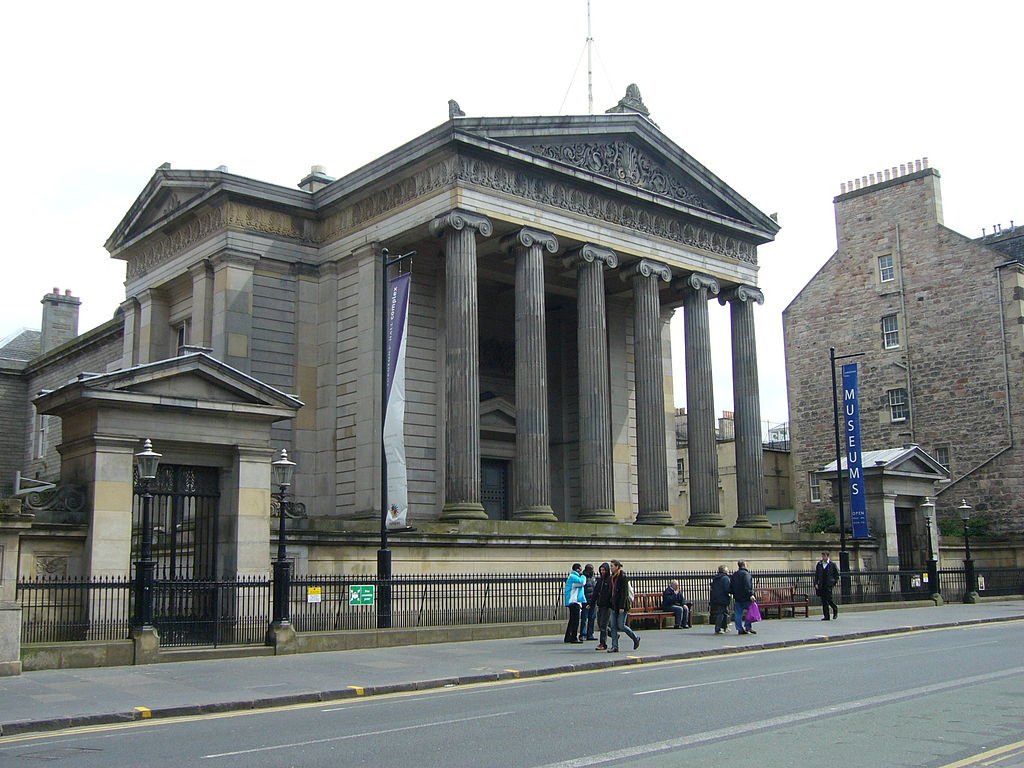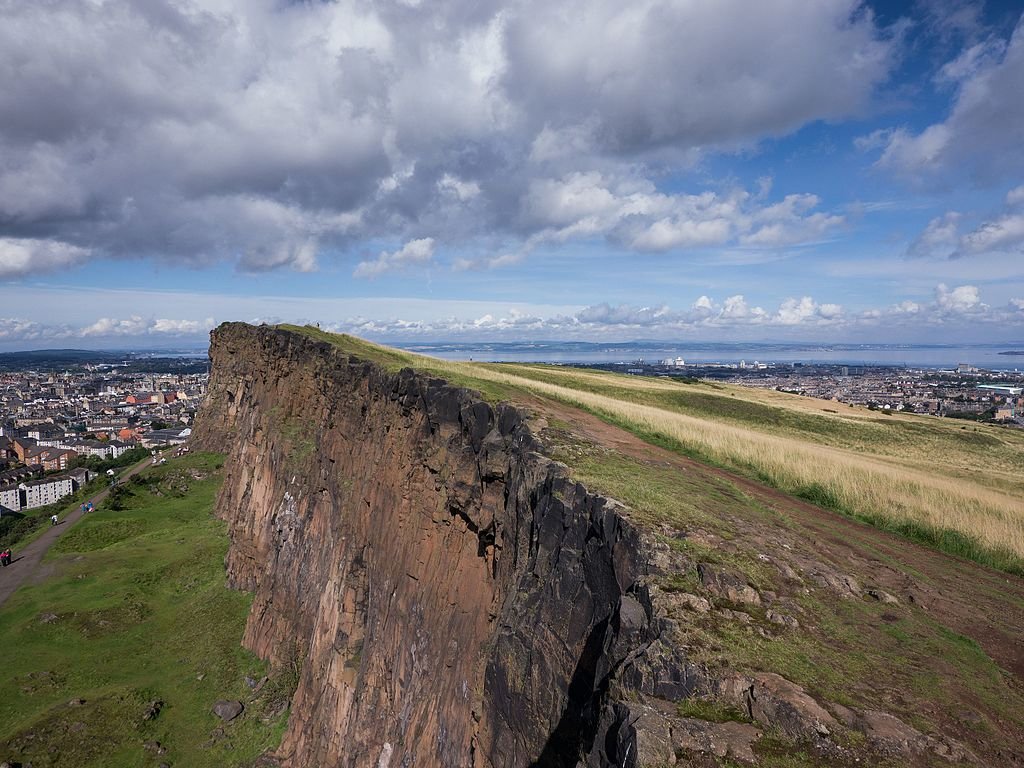Travel Guide to Edinburgh, Scotland - the Athens of the North
Affiliate disclosure: some of the links in this article are affiliate links. If you book using one of them, we’ll earn a small commission. All of our info is free to read and free of ads, so we appreciate it!
Edinburgh is one of Europe’s most mesmerically beautiful cities: not for nothing has it been nicknamed ‘Athens of the North’ since the 18th century.
Scotland’s capital lies nestled between seven hills, two of which, Castle Rock and Arthur’s Seat, are dramatic volcanic crags. It’s bounded by the glimmering Firth of Forth estuary to the north and the rolling Lammermuir Hills to the south, and with one of Great Britain’s grandest castles crowning its center and a medieval Old Town interlaced with steep atmospheric alleyways fanning out all around, it’s a city that cannot fail to impress.
But Edinburgh is not just a pretty face; it’s also one of Europe’s foremost cultural powerhouses, infused with the spirit of writers like Robert Louis Stevenson, Arthur Conan Doyle and J.K. Rowling, inventors like Alexander Graham Bell, musicians like the Proclaimers and internationally renowned festivals like the Edinburgh Festival.
The city lures you in with its good looks, then enthrals with the myriad rich veins of its heritage.
Table of Contents
Local help with your planning
If you’re planning a visit to Edinburgh, or Scotland more broadly, and could use some help coming up with a great plan, consider scheduling a Scotland travel consultation with Chris, our Local Expert in the United Kingdom.
These are one-hour Zoom calls where you get to chat with Chris, a local guide and tour leader throughout Scotland and the United Kingdom, about the trip you’re planning and get his expert tips and advice, answers to your travel questions, and help you perfect your itinerary.
Why visit
Edinburgh’s appeal for me is in how it combines a millennium or more of rich and varied history, some exceptional and internationally renowned museums, and a bewitching natural setting into one exceptional package.
Exhibiting every architectural style from the medieval to the Georgian to the contemporary, this really is a city of many ages. When you wander the Old Town you will be lost in unbroken views of medieval buildings – and many of the most important events in Scottish history either occurred or are remembered here.
Yet Edinburgh is justly renowned for its slick contemporary architecture too, such as that exhibited in Dean Village and in Leith’s waterfront rejuvenation.
The array of Edinburgh’s cultural attractions is so vast and varied, too: here, museums celebrate modern and ancient art, famous writers, plague victims and even the history of surgery. The city is known for having one of the liveliest festival programmes in the UK, too, which makes visiting at any time of year extra special.
Add in to all of this, meanwhile, is one of the most stunning natural settings of any city in Europe: heather-carpeted hills to the south and the sea to the north and east, while volcanic crags and alluring hills dot the city itself.
This means you’ll have ample opportunity to mix up city sightseeing with some exquisite coastal, riverside, woodland and hill walks – something few cities of such a large size provide.
Where is Edinburgh?
Edinburgh, Scotland’s capital city, is in the south of Scotland on the country’s east coast, overlooking the Firth of Forth estuary to the north and east, and the Lammermuir Hills to the south.
The city is 47 miles east of Scotland’s other major city, Glasgow, 58 miles northwest of Scotland’s southern border with England - near Jedborough -, and 410 miles north of London in England.
One of Edinburgh’s unique features is its proximity to some ravishingly beautiful and surprisingly rural countryside: within a few miles of the city center you can be roaming along pretty coastline next to villages like Cramond, hillwalking in the Lammermuir Hills, or taking boat trips to discover one of the UK’s most important seabird populations.
In fact, some of my favorite experiences in Edinburgh are actually exploring the rural landscape surrounding the city.
How to get here
The main ways of getting to Edinburgh are by flight to Edinburgh Airport, or by train or bus from Glasgow (Scotland) or London (England).
By flight to Edinburgh Airport
Edinburgh Airport has regular daily direct connections with New York City and Boston in the United States, and is very well connected to many European cities, making getting here by plane a breeze.
There are also many daily flights from London, operated by a mix of British Airways and low cost carriers. Flights take 1.5 hours and can cost as little as about $20 USD one-way.
By train or bus from Glasgow
Glasgow is Scotland’s other major transportation hub besides Edinburgh and is a useful place to connect to Edinburgh from. From Glasgow Queen Street, trains run every 15 minutes and take about 45 minutes to Edinburgh Waverley. Tickets cost around $20.
You can easily get to Edinburgh by bus from Glasgow too. Buses run from Glasgow’s Buchanan Street bus station to Edinburgh Bus Station near St Andrew’s Square in the New Town. They run every 15 minutes, take 1.5 hours and cost around $10.
By train or bus from London
London in Southern England is, as the major hub for travelers flying into the UK from overseas, also a useful base for beginning a trip to Edinburgh. The train service is efficient and, factoring in the additional waits at airports, just as quick as flying. Trains run from London Kings Cross (direct) or London Euston (with a change at Carlisle) hourly, taking 4.5 to 5 hours.
Ticket prices for one-way journeys are between $75 and $160, depending how much in advance you purchase the ticket and whether they run at peak or off-peak times (off-peak times are generally cheaper).
You can also take a long-distance bus from London to Edinburgh. There is one morning and a couple of overnight buses running from London Victoria coach station to Edinburgh daily. Journey time is nine hours and ticket prices start at around $25.
By car
Edinburgh is around seven hours drive north of London and one hour’s drive east of Glasgow, and is reached by easy highway driving from either city.

Connect with Scotland travel expert Chris for help perfecting your itinerary, answers to all your travel questions, and fabulous local tips for a better visit!
Best time to visit
July and August, the high season, is when Edinburgh comes alive with a rich calendar of festivals, making it unquestionably the most fun period in which to visit the city.
While crowds are also at their greatest at this time, the warmer weather (with average highs of 66°F), sunnier skies, and August’s cultural extravaganza that is the Edinburgh Festival – including the Edinburgh Fringe, the Edinburgh International Festival, and the Royal Edinburgh Military Tattoo – lends an especially vibrant dimension to city explorations.
You’ll have tons of daylight hours, good weather for city exploration, and something to do at any time of day.
Shoulder season: April-June and September
Traveling to Edinburgh in the spring or late summer/early fall will see you enjoying the city with fewer crowds, and you’re still likely to have quite good weather. It won’t be as nice as at the height of summer, but this is a very pleasant time to be here.
Low season: October-April
There are some arguments to be made for visiting Edinburgh in the low season, as the city still sports a vibrant schedule of cultural events at this time, but the weather is invariably poor, with many gloomy rainy days and pretty cold temperatures.
The crowds are at their lowest though and prices drop considerably for accommodation, so you’ll have a more “local” and affordable trip if you choose to come.
Highlights at this time are the city’s several Christmas markets and the lively Hogmanay celebrations on New Year’s Eve.
How long to spend
You can see the highlights of Edinburgh in a long weekend (3 days), but to get the best possible experience from the city and its immediate surroundings, you need 5 or 6 days.
Three days gives you the time to see the main historic Old Town sights, starting with the iconic Edinburgh Castle, major museums such as the National Gallery of Scotland, and get a feel for some of Edinburgh’s interesting outlying neighborhoods, like Leith.
With 5 or 6 days, you can really delve a bit deeper into the city, adding in some of the less-visited sights and making memorable day trips to the spectacular nearby sights.
3 Days: Edinburgh’s highlights
Day 1
Begin day one with a half-day tour of Edinburgh Castle, the fortress that forms the center of the Old Town and the city. From there, make your way along the centuries-old Royal Mile, the thoroughfare leading down through the Old Town from the castle. There’s so much to do on this stretch that this could easily occupy you the rest of today and most of the next day too!
Explore underground Edinburgh at The Real Mary King’s Close, take a journey through the history of whisky at the Scotch Whisky Experience, and spend time exploring the labyrinthine alleys and passageways of the Old Town.
Day 2
Continue your exploration of the Old Town today: visiting the Museum of Scotland (Scotland’s most important museum), seeing the Royal residence of the Palace of Holyrood house and its splendid ruined abbey, and taking a walk around Holyrood Park – not missing the climb up to Arthur’s Seat, the city’s highest point-.
With a focused day, you might also squeeze in a visit to one of the UK’s most impressive art galleries, the New Town’s National Gallery of Scotland.
Day 3
Opt for a more relaxed third day, perhaps taking in the striking New Town Georgian architecture at Charlotte Square, strolling around the beautiful Royal Botanic Gardens with its startling plant variety and then heading to the Edinburgh waterfront at rejuvenated Leith to look at the Royal Yacht Britannia and dine at one of the many highly regarded dining venues.
5-6 Days: The capital in full color
With an extra 2 or 3 days, you can more thoroughly explore Old Town’s attractions and add in visits to other sights such as the bizarre Surgeons Hall Museum or the Writer’s Museum.
Then, on days 4 and 5, take some day trips out of the city. Interesting options include heading to the pretty seaside village of Cramond, out to North Berwick to take a boat trip to see one of the UK’s biggest seabird populations on Bass Rock, or over to mystery-swathed Rosslyn Glen and Rosslyn Chapel.
Edinburgh has some incredible viewpoints and it’s worth exploring some of these on Day 6. One of the best is Calton Hill, equipped with the Acropolis-like National Monument and a contemporary art gallery in the former observatory.
The New Town is probably also deserving of more of your time on your last day, and it’s here that you could explore the serene Dean Village area and its interesting art museums.
Where to stay
For the average visitor, especially a first-time one, there are two logical parts of the city in which to stay: the Old Town, and the New Town. Both are good choices and have a wide selection of accommodations, so which one is better for you will depend on what you're looking for.
The Unesco-listed Old Town is Edinburgh’s historic heart, centered around Edinburgh Castle. It’s an atmospheric district of centuries-old buildings and narrow, steep cobbled alleys, close to many of the city’s major historic sights.
Edinburgh New Town is still pretty old (18th century) and one of the most striking examples of widescale Georgian architecture anywhere in the UK. Like the Old Town, it is Unesco-listed and contains major attractions like the National Gallery of Scotland and Royal Botanic Gardens.
Old Town hotels
The Witchery: With features such as roll-top baths, tracery windows, carved oak panelling from nearby St Giles Cathedral and four-poster beds, the nine lavish suites at The Witchery in a close of 16th-century buildings near Edinburgh Castle are frequently featured in lists of the world’s most exceptional accommodations.
CoDe The Court: This luxury beautifully refurbished hostel is situated in a former courthouse, with a mixture of dorms and private rooms. Breakfast is available, there is an underground bar and the hostel can help with Edinburgh tours.
New Town hotels
Balmoral Hotel: This grand 187-room hotel and spa with its landmark clock tower near Edinburgh Waverley station in the New Town gives you a glamorous welcome to the city. It also has a well-regarded restaurant, specializing in Scottish cuisine.
Kimpton Charlotte Square: In a handsome building on Charlotte Square, Edinburgh New Town’s defining example of Georgian architecture, this boutique offering features a spa, a courtyard café and a restaurant, Baba, serving Middle Eastern-Scottish cuisine.

What to see & do
1. Explore Edinburgh Castle
Simply put, this is one of the world’s great fortresses. Cresting a steep crag in the middle of the Old Town, Scotland’s grandest and most visited castle boasts almost a millennium of history.
Highlights include the Crown Room, containing the Scottish Crown Jewels, the Great Hall created by Scottish king James IV with its remarkable hammer-beam roof, and St Margaret’s Chapel, one of the oldest (c. 1100 AD) surviving and highest points of the castle and commemorating the wife of another Scottish king, Malcolm III.
2. Wander the Royal Mile and its wynds
When it comes to Edinburgh’s Old Town, often the best thing you can do is just wander: exploring the steep cobbled alleyways (known as wynds ) that lead to secret courtyards and closes (private little alleys for residents of an area) from the Royal Mile, the main street connecting Edinburgh Castle at the top with the Palace of Holyrood House.
The constantly surprising layout is sure to make you feel like you are the first-ever traveler to discover some of the tucked-away buildings and passageways.
3. Climb Calton Hill for ancient monuments and astounding views
This was Treasure Island writer Robert Louis Stevenson’s favorite spot in Edinburgh and climb to the top of one of Calton Hill today and you may well agree. Being one of the city’s seven hills and sporting the National Monument, an unfinished Parthenon-like structure erected in the 1820s to commemorate the fallen in the Napoleonic War, helps Calton Hill earn Edinburgh its comparison to Athens.
You can also find Collective, a contemporary art gallery in the refurbished former city observatory, on the hill.
4. Adventure through underground Edinburgh in The Real Mary King’s Close
Originally blocked off by the city council to contain a plague outbreak (with still-alive residents blocked in with them) and later built over during the development of Edinburgh New Town in the 18th century, this is an eerie labyrinth of underground streets and alleys.
Guides will show you around this compelling snapshot of old Edinburgh, revealing gruesome stories a-plenty on the way.
5. Relax in the Princes Street Gardens
The Princes Street Gardens are a pair of public parks sitting directly below Edinburgh Castle. Built in the early 1800’s as a result of the development of the New Town and draining of Nor Loch, this is now one of the city’s most recognizable green spaces.
Running along either side of Princes Street and divided by the The Mound, the artificial hill that separates the Old Town from the New Town, the Gardens are a popular spot for locals and tourists alike to meet up, hang out, and enjoy some lovely scenery.
Conveniently located nearby the National Gallery of Scotland and the Royal Scottish Academy, they make the perfect sightseeing pit stop from a busy day of sightseeing.
6. Discover the wonders of the Museum of Scotland
The phenomenal Museum of Scotland displays all manner of treasures and finds relating to Scotland’s long and storied history. Expect to see items such as the Lewis chess pieces, one of the oldest and most beautifully-carved surviving chess sets in the world, the travel set of cutlery of Bonnie Prince Charlie, the last serious pretender to the throne of Scotland and the belongings of colorful monarch Mary Queen of Scots.
7. Check out the Old Town’s lesser-known museums
Beyond the main sights in the Old Town, there are any number of smaller and more unusual museums worth spending time in. The Writer’s Museum, for example, is dedicated to three of Scotland’s key writers – Robert Louis Stevenson, Sir Walter Scott and Robert Burns – their work and personal memorabilia.
Meanwhile the Surgeon’s Hall Museum, one of Edinburgh’s quirkiest cultural highlights, contains the world’s largest historic collection of surgical pathology. You can expect an up-close look at the likes of bone specimens, Edinburgh’s famous grave-robbers William Burke and William Hare, and surgical-themed works of art.
The Surgeons’ Hall Museum. Photo: Kim Traynor, CC BY-SA 3.0, via Wikimedia Commons
8. Sample Scotland’s national drink at the Scotch Whisky Experience
For anyone with even a cursory interest in uisge beatha (Scottish whisky, the only sort of whisky in the world that is spelled without the e), this is the place for you. It houses the world’s largest private collection of Scotch whisky and whisks you on a journey in a whisky barrel through the production process of the drink.
Whisky tastings are included on the tours.
9. Visit the 16th-century Palace of Holyrood House
This is the official residence of the Royal Family in Scotland, with the current building dating back at least to the early 16th century. Leaders of Britain who have been indelibly associated with the palatial building include Charles II, who added the Royal Apartments, Mary Queen of Scots, who saw her then husband murder her secretary in Queen Mary’s Bedchamber, and Bonnie Prince Charlie, who briefly had his base of operations here during the Jacobite Rebellion.
The majestic ruins of 12th-century Holyrood Abbey can also be visited.
10. Take a hike around Holyrood Park
In Edinburgh, your stroll in the park becomes a fully-fledged hike in extensive (and often steep!) Holyrood Park. It’s a wild-feeling expanse covering some 650 acres: a mixture of gorse-covered moor, rocky outcrops and loch.
You can clamber up the crags to Arthur’s Seat, the park’s highest point, for great views over the city, and there are many miles of paths.
Photo: ermell, CC BY-SA 4.0, via Wikimedia Commons
11. Delve into the superb art collection of the National Gallery of Scotland
The Neoclassical-style National Gallery of Scotland alongside Princes Street Gardens in the New Town is a repository for some of the most exceptional Scottish artworks around, plus a stunning collection of work by international artists including Van Gogh, Cezanne, Botticelli, Raphael and many more.
Sir Henry Raeburn’s Reverend Robert Walker Skating on Duddingston Loch (a loch in Holyrood Park) is the highlight of the Scottish art.
Photo: Klaus with K, CC BY-SA 3.0, via Wikimedia Commons
12. Enjoy the tranquillity of the Royal Botanic Gardens
Founded in 1670, this is the UK’s second-oldest botanic gardens and one of the world’s most important. These astounding gardens contain over 13000 plant species: 4% of the total of plant species known worldwide.
Highlights include the glasshouses, some dating from the mid-19th century, with their impressive palm, orchid and cycad collections, the giant water lily pond, and the large collection of Chinese plants. Find the gardens north of Stockbridge, a mile north of the New Town’s Princes Street Gardens.
The Garden’s Palm House. Photo: Ham, CC BY-SA 3.0, via Wikimedia Commons
13. See Dean Village
Tranquil Dean Village fans out around the Water of Leith in streets of gorgeous, colorful architecture. It’s an interesting place to take a stroll, particularly as it is the home of two wonderful modern art galleries: the Gallery of Modern Art and Dean Gallery.
14. Board the famous Royal Yacht Britannia in Leith
When the Royal Yacht Britannia, the glamorous vessel of former royals, was taken out of service in 1997, it found a permanent home in Leith, and the ship is now one of this neighborhood’s foremost attractions.
Having hosted the likes of Sir Winston Churchill and Nelson Mandela, the ship offers touching insights into royal life aboard ship, such as the State Dining Room, where Queen Elizabeth II would entertain guests, and the Queen’s Bedroom, which during the last years of Queen Elizabeth II’s reign was the only living monarch’s bedroom on view to the general public.
The waterfront in Leith. Photo: en:User:Zaian, Public domain, via Wikimedia Commons
15. Unlock the mysteries of Rosslyn Chapel
Dating from 1446, the mystery-steeped Rosslyn Chapel, plunged within a beautiful wooded glen in the countryside close to Edinburgh, has captivated visitors for centuries. It’s a splendid Gothic construction featuring extremely elaborate stonework and has supposed associations with both the Kinghts Templar, a legendary order of medieval knights, and freemasonry.
It’s known as the setting for the finale of the Dan Brown novel (and later film) The Da Vinci Code. Bus 37 from near Edinburgh Waverley station runs here.
16. Take a trip to the seaside at Cramond
Edinburgh’s most atmospheric seaside suburb is Cramond, a couple of miles north of the city center. This small harbour on the Firth of Forth shoreline is a bunch of historic white houses, including one of Scotland’s best waterfront pubs.
A causeway leads out to the interesting Cramond Island, home to several WW2 fortifications, and there are lots of lovely coastal walks.
17. Learn all about Scotland’s seabirds in North Berwick
This seaside town 28 miles northeast of Edinburgh and accessible by a regular 40-minute train journey is the address for some of the most spectacular concentrations of seabirds in Scotland.
Boat trips run out to Bass Rock, where tens of thousands of seabirds congregate, and you can visit the Scottish Seabird Centre in town to find out much more about these birds.
Bass Rock, off the coast from North Berwick

Connect with Scotland travel expert Chris for help perfecting your itinerary, answers to all your travel questions, and fabulous local tips for a better visit!
Restaurants and dining
There is a dynamic range of places of eat out in ever-inventive Edinburgh’s food scene. The café culture rivals Rome for the sheer abundance of charming spots for coffees, brunches and light lunches. Meanwhile, the capital is renowned for its great seafood, especially down in waterfront Leith.
Other traditional Scottish dishes, like haggis, a savoury pudding consisting of sheep’s pluck (liver, lungs and heart), oatmeal and suet, or Cullen skink, a smoked haddock and potato soup, are available citywide.
Edinburgh is also known for its innovative world cuisine, from Italian to Indian.
Restaurants to try
Black Medicine: In the New Town, this is for me perhaps the finest place for coffee in the city. Named after the word Native American peoples apparently had for java, this is a great spot for students and visitors alike. Good bagels and soups are also served.
Mother India Café: Superb, long-established Edinburgh Old Town venue specializing in Indian tapas, from sweetcorn and paneer masala to spiced haddock.
The Witchery: This sumptuous Old Town dining destination in a cluster of 16th-century buildings near the castle cooks up a Scottish feast: Perthshire game, Scottish Borders beef, and west coast seafood.
Valvona and Crolla: Scotland’s oldest deli, established in 1934, specialises in Italian produce. The address in Edinburgh’s New Town is the perfect place to stock up for a picnic from its cheeses to its cured meats and fresh fruit and veg coming in from the market in Milan.
The Kitchin: Spelled deliberately thus to reflect the chef, Tom Kitchin, who is behind this Michelin starred Leith restaurant, this is one of Edinburgh’s best places to eat. The concept is simple: seasonal, fresh Scottish produce arrives daily, with all the butchering and filleting done on site, ready to be cooked using French techniques. It’s one of several wonderful places to eat out in Leith.
The shore area of Leith: This is not a specific restaurant, but rather a recommendation for an entire area for anyone looking for some seafood. All along the shore in Leith are very good local spots that serve up fresh seafood. The Ship on the Shore, Fishers, The Shore, etc., are a few examples, but there are many more.































